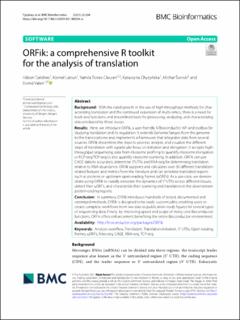ORFik: a comprehensive R toolkit for the analysis of translation
Tjeldnes, Håkon; Labun, Kornel; Torres Cleuren, Yamila Nicole; Chyzynska, Katarzyna; Swirski, Michal; Valen, Eivind Dale
Journal article, Peer reviewed
Published version

Åpne
Permanent lenke
https://hdl.handle.net/11250/2976055Utgivelsesdato
2021Metadata
Vis full innførselSamlinger
- Department of Informatics [915]
- Registrations from Cristin [9450]
Sammendrag
Background
With the rapid growth in the use of high-throughput methods for characterizing translation and the continued expansion of multi-omics, there is a need for back-end functions and streamlined tools for processing, analyzing, and characterizing data produced by these assays.
Results
Here, we introduce ORFik, a user-friendly R/Bioconductor API and toolbox for studying translation and its regulation. It extends GenomicRanges from the genome to the transcriptome and implements a framework that integrates data from several sources. ORFik streamlines the steps to process, analyze, and visualize the different steps of translation with a particular focus on initiation and elongation. It accepts high-throughput sequencing data from ribosome profiling to quantify ribosome elongation or RCP-seq/TCP-seq to also quantify ribosome scanning. In addition, ORFik can use CAGE data to accurately determine 5′UTRs and RNA-seq for determining translation relative to RNA abundance. ORFik supports and calculates over 30 different translation-related features and metrics from the literature and can annotate translated regions such as proteins or upstream open reading frames (uORFs). As a use-case, we demonstrate using ORFik to rapidly annotate the dynamics of 5′ UTRs across different tissues, detect their uORFs, and characterize their scanning and translation in the downstream protein-coding regions.
Conclusion
In summary, ORFik introduces hundreds of tested, documented and optimized methods. ORFik is designed to be easily customizable, enabling users to create complete workflows from raw data to publication-ready figures for several types of sequencing data. Finally, by improving speed and scope of many core Bioconductor functions, ORFik offers enhancement benefiting the entire Bioconductor environment.
